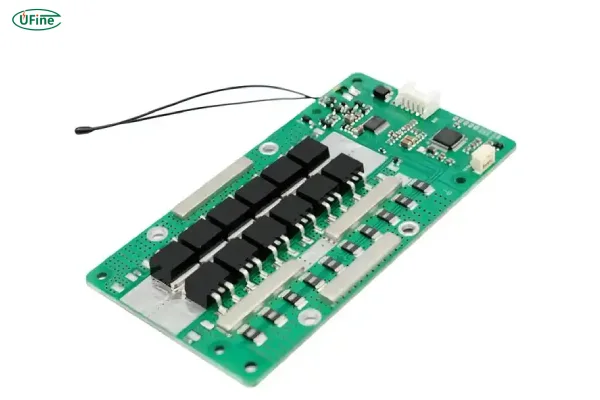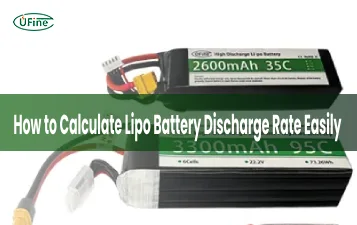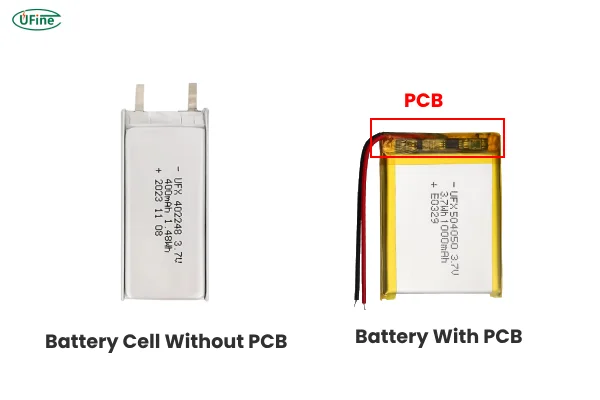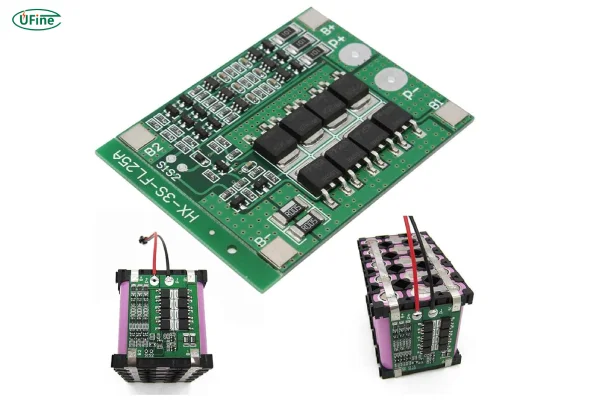Lithium batteries are known for their sensitivity to voltage, temperature, and current. That’s why most lithium batteries are paired with a lithium battery protection board, also known as a battery PCB.
So, the question arises: Can lithium batteries be used without a protection board? At Ufine Battery, we often receive this question, especially from customers working with limited space or strict budgets. While the short answer is “yes, under certain conditions,” the full story is more complex—and worth understanding before making that decision.
Part 1. What is a lithium battery protection board (PCB)?

A lithium battery protection board (PCB) is a small circuit module that acts as the battery’s security system. Its main function is to prevent dangerous operating conditions, including:
- Overcharge: Prevents the battery voltage from rising too high.
- Over-discharge: Stops the battery from draining below safe levels.
- Overcurrent or short-circuit: Cuts power if the current exceeds safe limits.
- Overheating: Shuts down or limits power to avoid thermal runaway.
These protective features are essential because lithium batteries, while efficient, are extremely sensitive. Many manufacturers require a protection board to ensure safe operation. However, some applications call for flexibility.
Choosing Between Unprotected and Protected Batteries
Part 2. Why some customers want to skip the protection board
At Ufine Battery, we understand that not every project is the same. Some of our customers come to us with special requests—custom lithium battery solutions where space or cost are critical.
Here are the three most common reasons customers ask us to supply lithium batteries without a PCB:
- Space Constraints: In compact electronics, even a few millimeters can make a big difference. Devices like wearables, wireless sensors, or slim medical tools may not have room for a PCB.
- Cost Efficiency: For low-margin products or high-volume manufacturing, every cent counts. Removing the protection board can reduce costs, though at the expense of built-in safety.
- External Protection Exists: Some designs already include protection at the system level. For example, a device may have its own voltage regulation, overcurrent protection, or smart charging built in.
Part 3. Risks of using lithium batteries without a protection board
Despite the flexibility, there are real risks to consider when using lithium batteries without a battery protection board:
- Overcharging: Without a PCB, a lithium battery can be charged beyond its rated voltage. This could cause swelling, leakage, or even fire and explosion.
- Over-discharging: Draining a lithium battery too low can cause irreversible damage to its internal chemistry. This reduces capacity and may render the battery unusable.
- Short-circuits and Thermal Runaway: Without overcurrent protection, a short-circuit could result in rapid heating, fire, or in severe cases, explosions.
- Shorter Lifespan: Unprotected batteries are more likely to degrade faster due to improper voltage or temperature conditions.
At Ufine, we take these risks seriously. That’s why we only approve PCB-free lithium battery solutions after careful evaluation and testing.
Contact Ufine Battery today to discuss your custom project!
Part 4. Cases where lithium batteries can operate without a PCB
Despite the risks, there are legitimate cases where lithium batteries can safely operate without a PCB:
- Low-Risk, Single-Cell Applications: Devices with a single low-capacity cell and predictable current draw are generally safer.
- External Battery Management System (BMS): Some larger or professional devices use a centralized BMS instead of individual PCBs.
- Custom Chargers or Control Circuits: If the device includes its own voltage control, the protection board may be redundant.
For example, Ufine Battery has supplied LiFePO4 batteries for industrial clients who use smart charging docks that handle all the safety logic externally.
Part 5. Ufine Battery’s approach to PCB-Free custom batteries
At Ufine Battery, we’ve handled thousands of custom battery requests—including PCB-free designs. Here’s how we ensure safety:
Step 1: Risk Assessment
-
Is the battery single-cell or multi-cell?
-
What’s the application environment?
-
Are there external protections?
Step 2: Safer Chemistry Selection
-
We often recommend LiFePO4 for unstable conditions.
Step 3: Rigorous Testing
-
Overcharge/Discharge Simulations
-
Short-Circuit Stress Tests
-
Thermal Runaway Prevention Checks
Our Stance: We’ll only approve PCB-free designs if multiple safety layers exist.
Lithium Battery PCB vs. BMS: Key Differences Explained
Part 6. Alternatives to traditional protection boards
If a traditional PCB isn’t ideal for your project, Ufine Battery can help you explore alternatives:
- Use Safer Chemistries: As mentioned, LiFePO4 is more stable and forgiving than LiPo or standard Li-ion.
- Add Passive Safety Components: Devices like PTC thermistors, fuses, or voltage regulators can provide limited protection without needing a full PCB.
- Use Smart Charging Systems: Chargers with programmable protection logic can replace some PCB functions.
Part 7. When should you absolutely use a protection board?
While some applications can go without, there are scenarios where a battery protection board is essential:
- High-Capacity or Multi-Cell Packs: The risks grow with higher energy content and multiple cells.
- Consumer Electronics and Medical Devices: These products must meet safety standards—PCBs are a must.
- Unpredictable Charging Conditions: If you’re not sure how the device will be charged, a PCB is non-negotiable.
At Ufine Battery, we recommend erring on the side of caution unless you’re an expert with advanced safety design.
Part 8. Ufine Battery’s custom solutions for PCB-free needs
Ufine Battery is one of the few manufacturers in China willing to consider custom lithium batteries without protection boards—but only after a thorough review.
Here’s how we approach these projects:
- Client Evaluation: We ask about device voltage, charge/discharge current, environment, and external circuitry.
- Safer Chemistries: Where possible, we recommend LiFePO4 instead of standard Li-ion or LiPo, due to its higher thermal and chemical stability.
- Stringent Quality Control: Each unprotected battery is tested under various stress conditions. We verify capacity, internal resistance, temperature behavior, and voltage tolerance.
- Engineer Collaboration: We work closely with customer design teams to ensure safe integration.
If you need a battery for a space-constrained or cost-sensitive application, contact Ufine Battery. Our team will help you engineer a reliable, custom solution that fits your exact needs.
Part 9. Conclusion & recommendations
So—can lithium batteries be used without a protection board? Technically, yes. But it depends on your use case, expertise, and safety requirements.
Ufine Battery recommends using a battery protection board in most applications to ensure long life, reliability, and safety. However, for certain custom needs, we’re open to PCB-free solutions—with careful design, safe chemistries, and robust testing.
Let’s work together to build a lithium battery that performs reliably and fits your unique requirements.
Part 10. FAQs
Is it safe to use a lithium battery without a PCB?
Only under controlled conditions with proper external protection. Always consult an expert.
Can I remove the PCB from an existing battery?
Not recommended. This could damage the battery or cause dangerous behavior.
What’s the safest lithium battery chemistry for PCB-free use?
LiFePO4 is more stable and less prone to thermal runaway.
Does Ufine provide custom batteries without a PCB?
Yes, but only after evaluating the safety of your application and usage environment.
Can I use a smart charger instead of a battery protection board?
A: In some cases, yes. A charger with accurate voltage and current limits can help reduce the risk.
Related Tags:
More Articles

LiPo Battery Discharge Rate Guide & Calculation Tips
Understand LiPo battery discharge rates, C-ratings, and how to calculate max current. Essential guide for RC, drones, and electronics users.
High‑Capacity 3S LiPo Batteries: 5000 mAh vs. 10000 mAh
Compare 3S LiPo 5000mAh vs 10000mAh batteries by weight, power, and use. Find the best fit for your drone, RC car, or boat setup.
Top 5 Applications for Small 3S LiPo Batteries
Small 3S LiPo batteries power drones, RC gear, wearables, and robotics with high energy and low weight. Making them ideal for compact electronics projects.
Building and Charging Your Own 3S LiPo Pack: A Step‑by‑Step Guide
Learn how to build, balance, and charge a 3S LiPo battery pack safely at home with this complete DIY guide for hobbyists and beginners.
How to Choose the Right LiPo Battery Plug Type?
Discover the best LiPo battery plug types, how to choose them, and expert tips for safe usage, soldering, and maintenance.





